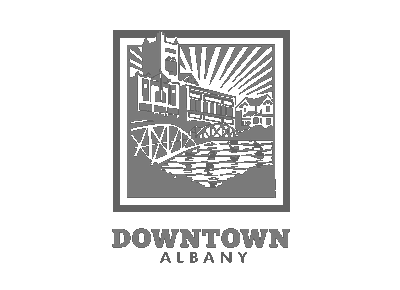A modern roundabout is a circular intersection without traffic signals, engineered to keep traffic moving smoothly and safely.
In Oregon, the cities including Portland, Bend, and Corvallis have installed several roundabouts and plan for more. In the cities and towns where roundabouts are used, drivers praise them for the increased capacity and safety they provide, along with traffic calming and aesthetic benefits. Studies done in the U.S. show that after converting more traditional intersections to roundabouts, total crashes declined by 39%. Injury crashes declined by 76%, and serious injury or fatal crashes dropped by 89%.
North Albany Road/Gibson Hill Road
Albany’s first modern roundabout is its smallest with a radius of 104 feet. The size was influenced by topography and to discourage big trucks from using Gibson Hill Road and the intersection as a cut through route. The roundabout was built when North Albany Road was extended to the north. The City chose a roundabout instead of a traffic signal to reduce potential crashes and because of steep grades at the intersection. The road there has a history of ice in winter. With a traffic signal, stopping and starting with ice on the slope would have been difficult. Since it was installed, this roundabout has had fewer and less severe crashes than similar busy intersections with traffic signals.
Knox Butte Road/Timber Ridge
Albany’s largest roundabout has a radius of 160 feet. It provides vehicle access to Timber Ridge School and a pedestrian route between the new school and residential neighborhoods to the south. The City considered safety and cost before choosing a roundabout here instead of a traffic signal. Fewer crashes occur in roundabouts, and in this case construction cost was also less. The Timber Ridge intersection is between a curve in Knox Butte Road and Truax Creek. A traffic signal would have put the intersection closer to the creek and required a wider bridge with turn lanes.
Main Street/Salem Avenue
Albany’s newest modern roundabout has a radius of 130 feet and was built to address ongoing safety and congestion at the intersection. The City had considered a traffic signal and a wider road there earlier, but chose a roundabout to reduce crashes, improve traffic capacity and flow, use less space and right of way, and for lower construction costs.
Using a roundabout
Passenger Vehicles
- When approaching the roundabout, follow the lane designation signs, slow down, and yield to pedestrians in crosswalks.
- Look to the left. Traffic in the roundabout has the right-of-way.
- Approach the yield line and enter the roundabout when there is an adequate gap in the circulating traffic flow.
- If another car is waiting at the yield line ahead of you, do not stop in the crosswalk. Keep the crosswalk clear for pedestrians.
- Bicyclists are permitted to ride in the roundabout and will be riding in the lane just as other vehicles do. Please do not pass a bicycle in the roundabout.
- Proceed counter-clockwise to your exit. You now have the right-of-way.
- As you approach your exit, turn on your right turn signal.
- Exit the roundabout, yielding to pedestrians in the crosswalk.
Trucks
- Drive on the roadway; large trucks and trailers may use the concrete truck apron to negotiate the tight turning radius.
- Drive (usually with just the rear wheels) on the raised concrete of the truck apron to navigate more easily.
- Cars should not use the truck apron.
Bicycles
- If you are comfortable riding in traffic, take the lane and circulate like you are a vehicle, making sure you yield to traffic in the circle when you enter.
- Ride at the speed of the circular roadway (about 15 to 20 mph) to discourage cars from passing you.
- When you exit the roundabout, use your right hand signal.
- If you are unsure about using the roundabout, dismount and walk your bike as a pedestrian at the designated crosswalks. When on the sidewalk, always yield to pedestrians.
Pedestrians
- Stay on the designated walkways at all times.
- Cross only at the designated crosswalks.
- Never cross to the central island.
- Watch for cars; you have the right-of-way, but your best protection is your own attention.
- Cross in the crosswalk one lane at a time, using the splitter island as a refuge area before crossing the next lane.
Other useful sites
- How to drive in a roundabout (ODOT)
- How to drive in a roundabout (DOT of New York)


